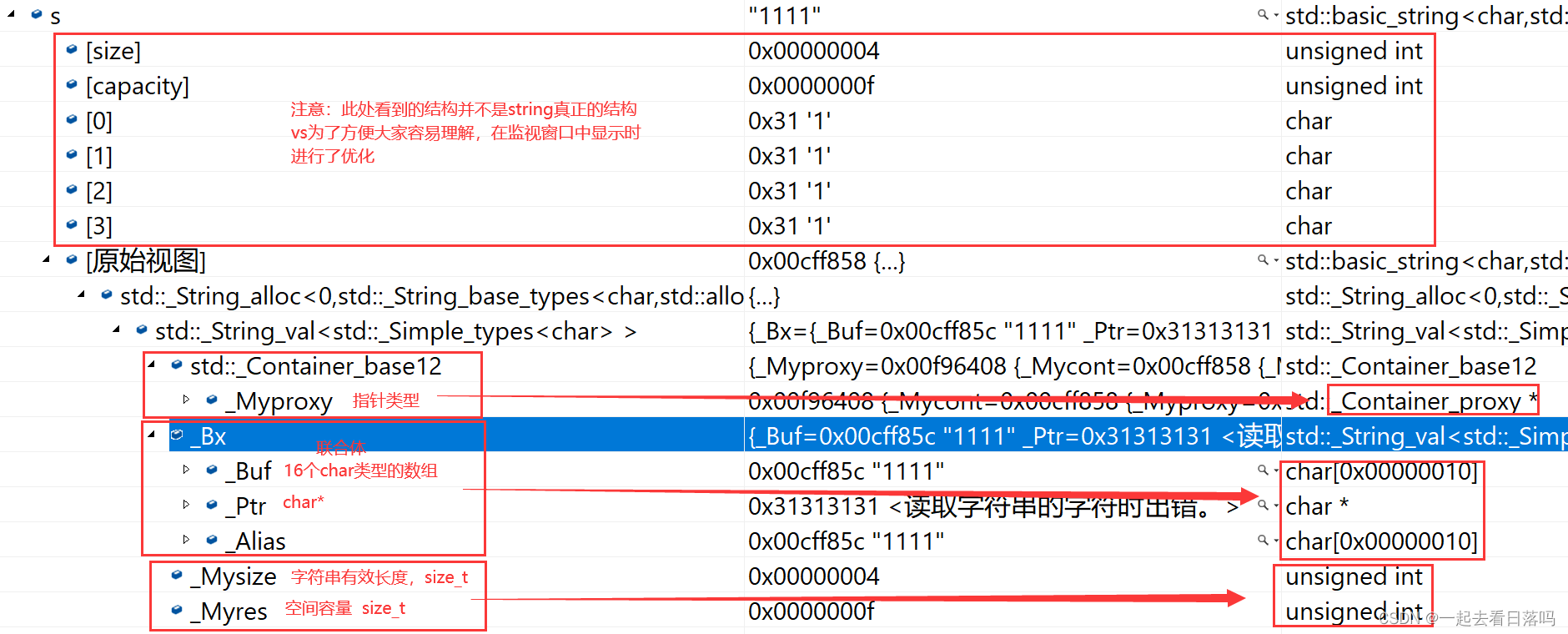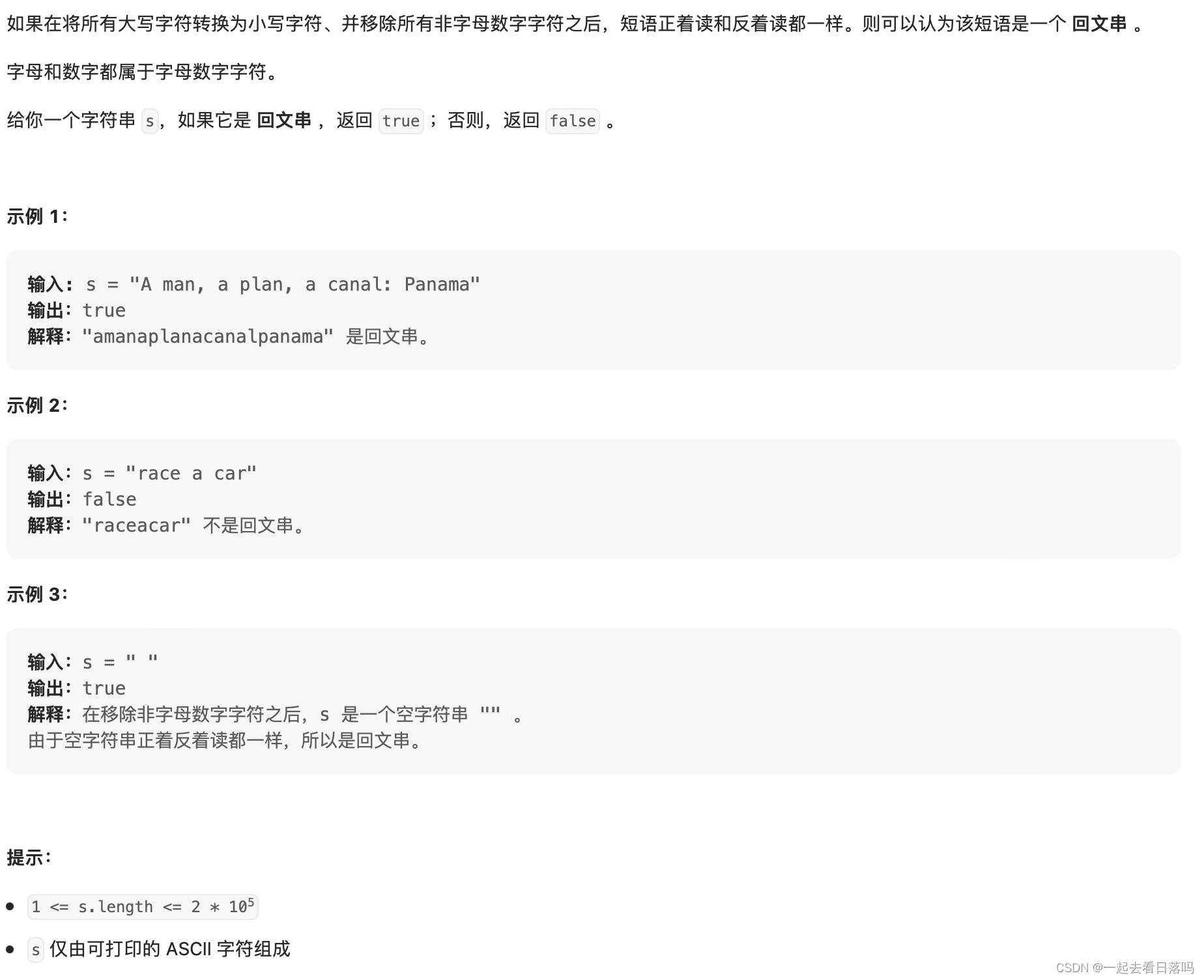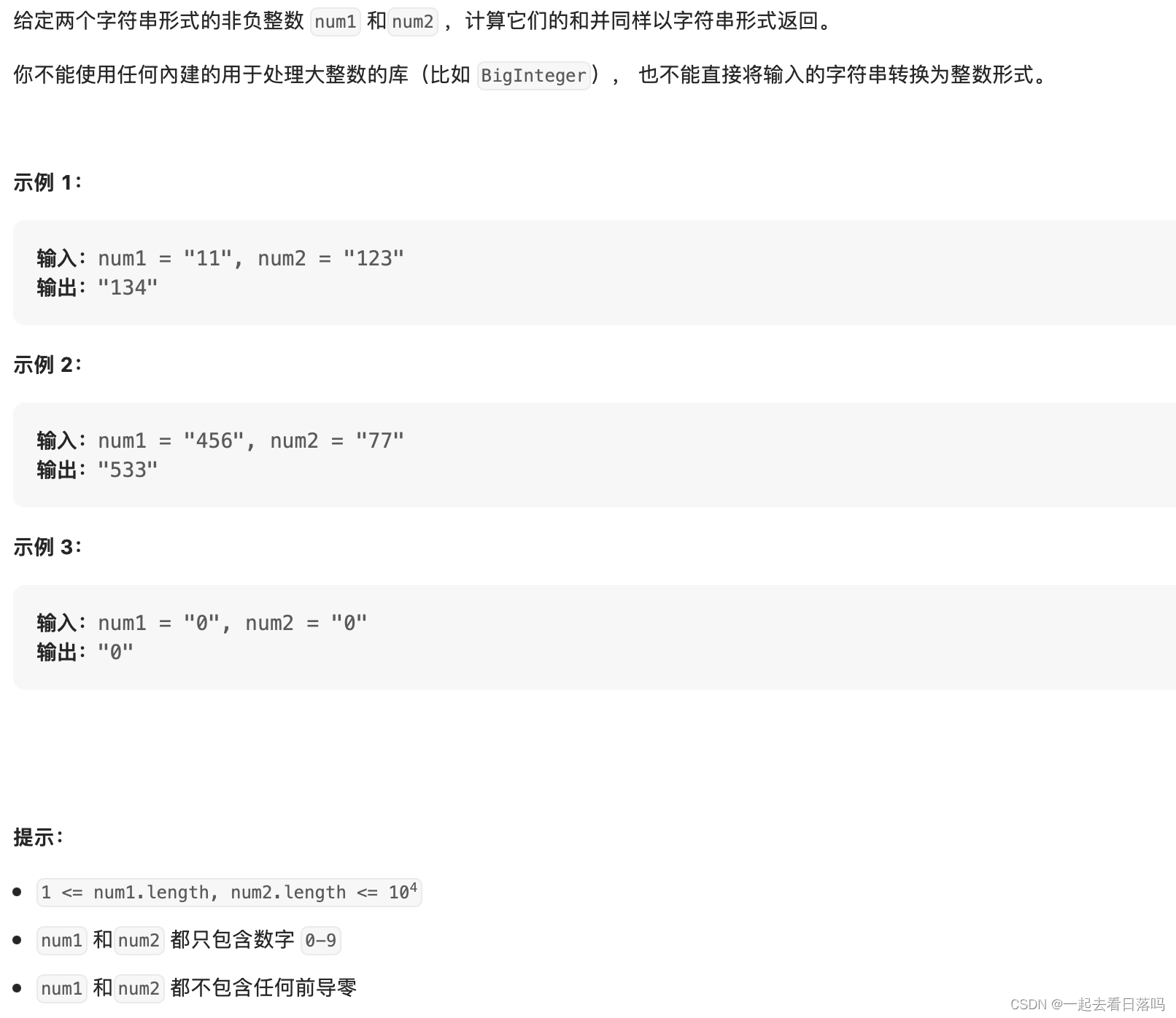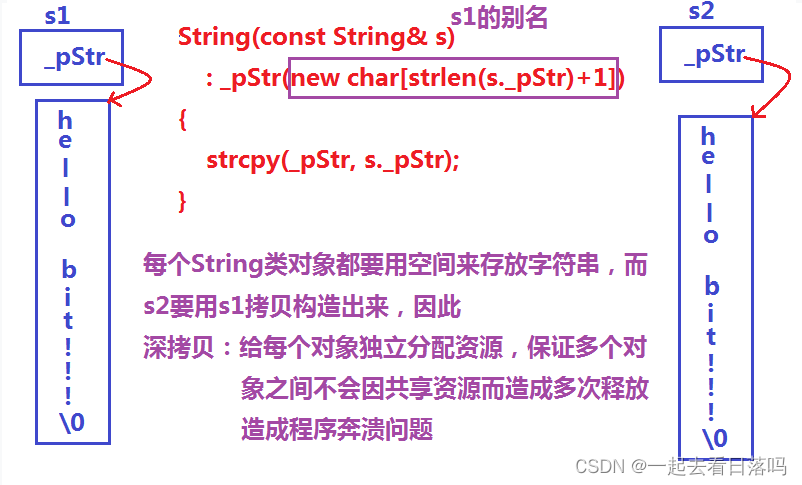【C++】STL——string(两万字详解)
🎇C++学习历程:STL——string学习
- 博客主页:一起去看日落吗
- 持续分享博主的C++学习历程
博主的能力有限,出现错误希望大家不吝赐教- 分享给大家一句我很喜欢的话: 也许你现在做的事情,暂时看不到成果,但不要忘记,树🌿成长之前也要扎根,也要在漫长的时光🌞中沉淀养分。静下来想一想,哪有这么多的天赋异禀,那些让你羡慕的优秀的人也都曾默默地翻山越岭🐾。
🍁 🍃 🍂 🌿
目录
- 🌿1. 为什么要学习string类?
- 🍃1.1 C语言中的字符串
- 🍃1.2 两个面试题(暂不做讲解)
- 🌿2. 标准库中的string类
- 🍃2.1 string类(了解)
- 🍃2.1 string类的常用接口说明(只讲解最常用的接口)
- 🍂2.1.1 string类对象的常见构造
- 🍂2.1.2 string类对象的容量操作造
- 🍂2.1.3 string类对象的访问及遍历操作
- 🍂2.1.4 string类对象的修改操作
- 🍂2.1.5 string类非成员函数
- 🍂2.1.6 vs和g++下string结构的说明
- 🍁小试牛刀(做题训练)
- 🍂第一题
- 🍂第二题
- 🍂第三题
- 🍂第四题
- 🍂第五题
- 🌿3. string类的模拟实现
- 🍃3.1 经典的string类问题
- 🍃3.2 浅拷贝
- 🍃3.3 深拷贝
- 3.3.1 🍂深拷贝的传统版写法的string类
- 3.3.2 🍂深拷贝的现代版写法的String类
- 🍃3.4 写时拷贝(了解)
- 🍃3.5 string类的模拟实现
- 🌿4. 拓展阅读
🌿1. 为什么要学习string类?
🍃1.1 C语言中的字符串
C语言中,字符串是以’\0’结尾的一些字符的集合,为了操作方便,C标准库中提供了一些str系列的库函数,但是这些库函数与字符串是分离开的,不太符合OOP的思想,而且底层空间需要用户自己管理,稍不留神可能还会越界访问。
🍃1.2 两个面试题(暂不做讲解)
字符串转整形数字
字符串相加
在OJ中,有关字符串的题目基本以string类的形式出现,而且在常规工作中,为了简单、方便、快捷,基本都使用string类,很少有人去使用C库中的字符串操作函数。
🌿2. 标准库中的string类
🍃2.1 string类(了解)
string类的文档介绍
- 字符串是表示字符序列的类。
- 标准的字符串类提供了对此类对象的支持,其接口类似于标准字符容器的接口,但添加了专门用于操作单字节字符字符串的设计特性。
- string 类是使用 char(即作为它的字符类型,使用它的默认 char_traits 和分配器类型 (关于模板的更多信息,请参阅 basic_string)。
- string 类是 basic_string 模板类的一个实例,它使用 char 来实例化 basic_string 模板类,并用 char_traits 和 allocator 作为 basic_string 的默认参数(根于更多的模板信息请参考 basic_string)。
- 注意,这个类独立于所使用的编码来处理字节:如果用来处理多字节或变长字符(如 UTF-8) 的序列,这个类的所有成员(如长度或大小)以及它的迭代器,将仍然按照字节(而不是实际编码的字符)来操作。
总结:
- string 是表示字符串的字符串类。
- 该类的接口与常规容器的接口基本相同,再添加了一些专门用来操作 string 的常规操作。
- string 在底层实际是:basic_string 模板类的别名,typedef basic_string<char, char_traits, allocator> string;。
- 不能操作多字节或者变长字符的序列。
在使用 string 类时,必须包含 string 头文件以及 using namespace std;

#include<string>
#include<iostream>
using namespace std;
int main()
{
cout << sizeof(char) << endl;
cout << sizeof(wchar_t) << endl;
char arr1[] = "hello bit";
char arr2[] = "byih";
return 0;
}
🍃2.1 string类的常用接口说明(只讲解最常用的接口)
🍂2.1.1 string类对象的常见构造
| (constructor) 函数名称 | 功能说明 |
|---|---|
| string() —— 重点 | 构造空的 string 类对象,即空字符串 |
| string(const char* s) —— 重点 | 用 C-string 来构造 string 类对象 |
| string(size_t n, char c) | string 类对象中包含 n 个字符 c |
| string(const string& s) —— 重点 | 拷贝构造函数 |
#include<string>
#include<iostream>
using namespace std;
//大概原理
template<class T>
class basic_string
{
T* _arr;
int _size;
int _capacity;
};
//typedef basic_string<char> string;
int main()
{
string s1;
string s2("hello");
string s3("byih");
string s4(10, 'a');
string s5(s2);
//对于string它重载了流提取和流插入等,这里就可以直接用
cout << s1 << endl;
cout << s2 << endl;
cout << s3 << endl;
cout << s4 << endl;
cout << s5 << endl;
//赋值 ———— 深拷贝
s1 = s5;
cout << s1 << endl;
}

s1虽然是无参的,但是他的第一个位置会有一个\0
🍂2.1.2 string类对象的容量操作造
| 函数名称 | 功能说明 |
|---|---|
| size —— 重点 | 返回字符串有效字符长度 |
| length | 返回字符串有效字符长度 |
| capacity | 返回空间总大小 |
| empty —— 重点 | 检测字符串释放为空串,是返回 true,否则返回 false |
| clear —— 重点 | 清空有效字符 |
| reserve —— 重点 | 为字符串预留空间 |
| resize —— 重点 | 将有效字符的个数改成 n 个,多出的空间用字符 c 填充 |

#include<string>
#include<iostream>
using namespace std;
void test_string1()
{
//1、size | length
string s1("hello world");
cout << s1.size() << endl;
cout << s1.length() << endl;
cout << "----------cut----------" << endl;
//2、max_size
string s2;
cout << s1.max_size() << endl;
cout << s2.max_size() << endl;
cout << "----------cut----------" << endl;
//3、capacity
cout << s1.capacity() << endl;
cout << "----------cut----------" << endl;
//4、resize
string s3("hello world");
cout << s3.size() << endl;
cout << s3 << endl;
//s3.resize(20);//n大于当前的字符串的长度且没有指定c,所以hello world\0\0\0\0...
//s3.resize(5);//n小于当前的字符串的长度, 它会删除掉从n开始的这些字符
s3.resize(20, 'x');//n大于当前的字符串的长度且指定c,所以hello worldxxxx...
cout << s3.size() << endl;
cout << s3 << endl;
cout << "----------cut----------" << endl;
//5、reserve
string s4("hello world");
s4.reserve(20);
cout << s4 << endl;
cout << s4.size() << endl;
cout << s4.capacity() << endl;
s4.reserve(10);
cout << s4 << endl;
cout << s4.size() << endl;
cout << s4.capacity() << endl;
cout << "----------cut----------" << endl;
//6、clear | empty
string s5("hello world");
cout << s5 << endl;
cout << s5.empty() << endl;;
s5.clear();
cout << s5 << endl;
cout << s5.empty() << endl;
cout << "----------cut----------" << endl;
//7、shrink_to_fit 暂且不演示
}
void test_string2()
{
string s;
size_t sz = s.capacity();
cout << "making s grow:\n" << sz << endl;
for(int i = 0; i < 500; ++i)
{
s.push_back('c');
if(sz != s.capacity())
{
sz = s.capacity();
cout << "capacity changed:" << sz << '\n';
}
}
cout << "----------cut----------" << endl;
}
int main()
{
test_string1();
test_string2();
return 0;
}
注意:
- size()与length()方法底层实现原理完全相同,引入size()的原因是为了与其他容器的接口保持一致,一般情况下基本都是用size()。
- clear()只是将string中有效字符清空,不改变底层空间大小。
- resize(size_t n) 与 resize(size_t n, char c)都是将字符串中有效字符个数改变到n个,不同的是当字符个数增多时:resize(n)用0来填充多出的元素空间,resize(size_t n, char c)用字符c来填充多出的元素空间。注意:resize在改变元素个数时,如果是将元素个数增多,可能会改变底层容量的大小,如果是将元素个数减少,底层空间总大小不变。
- reserve(size_t res_arg=0):为string预留空间,不改变有效元素个数,当reserve的参数小于string的底层空间总大小时,reserver不会改变容量大小。
🍂2.1.3 string类对象的访问及遍历操作
| 函数名称 | 功能说明 |
|---|---|
| operator[] (重点) | 返回pos位置的字符,const string类对象调用 |
| begin+ end | begin获取一个字符的迭代器 + end获取最后一个字符下一个位置的迭代器 |
| rbegin + rend | begin获取一个字符的迭代器 + end获取最后一个字符下一个位置的迭代器 |
| 范围for | C++11支持更简洁的范围for的新遍历方式 |
#define _CRT_SECURE_NO_WARNINGS
#include <iostream>
using namespace std;
#include <string>
// 测试string容量相关的接口
// size/clear/resize
void Teststring1()
{
// 注意:string类对象支持直接用cin和cout进行输入和输出
string s("hello, bit!!!");
cout << s.size() << endl;
cout << s.length() << endl;
cout << s.capacity() << endl;
cout << s << endl;
// 将s中的字符串清空,注意清空时只是将size清0,不改变底层空间的大小
s.clear();
cout << s.size() << endl;
cout << s.capacity() << endl;
// 将s中有效字符个数增加到10个,多出位置用'a'进行填充
// “aaaaaaaaaa”
s.resize(10, 'a');
cout << s.size() << endl;
cout << s.capacity() << endl;
// 将s中有效字符个数增加到15个,多出位置用缺省值'\0'进行填充
// "aaaaaaaaaa\0\0\0\0\0"
// 注意此时s中有效字符个数已经增加到15个
s.resize(15);
cout << s.size() << endl;
cout << s.capacity() << endl;
cout << s << endl;
// 将s中有效字符个数缩小到5个
s.resize(5);
cout << s.size() << endl;
cout << s.capacity() << endl;
cout << s << endl;
}
//====================================================================================
void Teststring2()
{
string s;
// 测试reserve是否会改变string中有效元素个数
s.reserve(100);
cout << s.size() << endl;
cout << s.capacity() << endl;
// 测试reserve参数小于string的底层空间大小时,是否会将空间缩小
s.reserve(50);
cout << s.size() << endl;
cout << s.capacity() << endl;
}
// 利用reserve提高插入数据的效率,避免增容带来的开销
//====================================================================================
void TestPushBack()
{
string s;
size_t sz = s.capacity();
cout << "making s grow:\n";
for (int i = 0; i < 100; ++i)
{
s.push_back('c');
if (sz != s.capacity())
{
sz = s.capacity();
cout << "capacity changed: " << sz << '\n';
}
}
}
// 构建vector时,如果提前已经知道string中大概要放多少个元素,可以提前将string中空间设置好
void TestPushBackReserve()
{
string s;
s.reserve(100);
size_t sz = s.capacity();
cout << "making s grow:\n";
for (int i = 0; i < 100; ++i)
{
s.push_back('c');
if (sz != s.capacity())
{
sz = s.capacity();
cout << "capacity changed: " << sz << '\n';
}
}
}
// string的遍历
// begin()+end() for+[] 范围for
// 注意:string遍历时使用最多的还是for+下标 或者 范围for(C++11后才支持)
// begin()+end()大多数使用在需要使用STL提供的算法操作string时,比如:采用reverse逆置string
void Teststring3()
{
string s1("hello Bit");
const string s2("Hello Bit");
cout << s1 << " " << s2 << endl;
cout << s1[0] << " " << s2[0] << endl;
s1[0] = 'H';
cout << s1 << endl;
// s2[0] = 'h'; 代码编译失败,因为const类型对象不能修改
}
void Teststring4()
{
string s("hello Bit");
// 3种遍历方式:
// 需要注意的以下三种方式除了遍历string对象,还可以遍历是修改string中的字符,
// 另外以下三种方式对于string而言,第一种使用最多
// 1. for+operator[]
for (size_t i = 0; i < s.size(); ++i)
cout << s[i] << endl;
// 2.迭代器
string::iterator it = s.begin();
while (it != s.end())
{
cout << *it << endl;
++it;
}
// string::reverse_iterator rit = s.rbegin();
// C++11之后,直接使用auto定义迭代器,让编译器推到迭代器的类型
auto rit = s.rbegin();
while (rit != s.rend())
cout << *rit << endl;
// 3.范围for
for (auto ch : s)
cout << ch << endl;
}
//
// 测试string:
// 1. 插入(拼接)方式:push_back append operator+=
// 2. 正向和反向查找:find() + rfind()
// 3. 截取子串:substr()
// 4. 删除:erase
void Teststring5()
{
string str;
str.push_back(' '); // 在str后插入空格
str.append("hello"); // 在str后追加一个字符"hello"
str += 'b'; // 在str后追加一个字符'b'
str += "it"; // 在str后追加一个字符串"it"
cout << str << endl;
cout << str.c_str() << endl; // 以C语言的方式打印字符串
// 获取file的后缀
string file("string.cpp");
size_t pos = file.rfind('.');
string suffix(file.substr(pos, file.size() - pos));
cout << suffix << endl;
// npos是string里面的一个静态成员变量
// static const size_t npos = -1;
// 取出url中的域名
string url("http://www.cplusplus.com/reference/string/string/find/");
cout << url << endl;
size_t start = url.find("://");
if (start == string::npos)
{
cout << "invalid url" << endl;
return;
}
start += 3;
size_t finish = url.find('/', start);
string address = url.substr(start, finish - start);
cout << address << endl;
// 删除url的协议前缀
pos = url.find("://");
url.erase(0, pos + 3);
cout << url << endl;
}
int main()
{
return 0;
}
🍂2.1.4 string类对象的修改操作
| 函数名称 | 功能说明 |
|---|---|
| push_back | 在字符串后尾插字符c |
| append | 在字符串后追加一个字符串 |
| operator+= (重点) | 在字符串后追加字符串str |
| c_str(重点) | 返回C格式字符串 |
| find + npos(重点) | 从字符串pos位置开始往后找字符c,返回该字符在字符串中的位置 |
| rfind | 从字符串pos位置开始往前找字符c,返回该字符在字符串中的位置 |
| substr | 在str中从pos位置开始,截取n个字符,然后将其返回 |
#define _CRT_SECURE_NO_WARNINGS
#include <iostream>
using namespace std;
#include <string>
// 测试string容量相关的接口
// size/clear/resize
void Teststring1()
{
// 注意:string类对象支持直接用cin和cout进行输入和输出
string s("hello, bit!!!");
cout << s.size() << endl;
cout << s.length() << endl;
cout << s.capacity() << endl;
cout << s << endl;
// 将s中的字符串清空,注意清空时只是将size清0,不改变底层空间的大小
s.clear();
cout << s.size() << endl;
cout << s.capacity() << endl;
// 将s中有效字符个数增加到10个,多出位置用'a'进行填充
// “aaaaaaaaaa”
s.resize(10, 'a');
cout << s.size() << endl;
cout << s.capacity() << endl;
// 将s中有效字符个数增加到15个,多出位置用缺省值'\0'进行填充
// "aaaaaaaaaa\0\0\0\0\0"
// 注意此时s中有效字符个数已经增加到15个
s.resize(15);
cout << s.size() << endl;
cout << s.capacity() << endl;
cout << s << endl;
// 将s中有效字符个数缩小到5个
s.resize(5);
cout << s.size() << endl;
cout << s.capacity() << endl;
cout << s << endl;
}
//====================================================================================
void Teststring2()
{
string s;
// 测试reserve是否会改变string中有效元素个数
s.reserve(100);
cout << s.size() << endl;
cout << s.capacity() << endl;
// 测试reserve参数小于string的底层空间大小时,是否会将空间缩小
s.reserve(50);
cout << s.size() << endl;
cout << s.capacity() << endl;
}
// 利用reserve提高插入数据的效率,避免增容带来的开销
//====================================================================================
void TestPushBack()
{
string s;
size_t sz = s.capacity();
cout << "making s grow:\n";
for (int i = 0; i < 100; ++i)
{
s.push_back('c');
if (sz != s.capacity())
{
sz = s.capacity();
cout << "capacity changed: " << sz << '\n';
}
}
}
// 构建vector时,如果提前已经知道string中大概要放多少个元素,可以提前将string中空间设置好
void TestPushBackReserve()
{
string s;
s.reserve(100);
size_t sz = s.capacity();
cout << "making s grow:\n";
for (int i = 0; i < 100; ++i)
{
s.push_back('c');
if (sz != s.capacity())
{
sz = s.capacity();
cout << "capacity changed: " << sz << '\n';
}
}
}
// string的遍历
// begin()+end() for+[] 范围for
// 注意:string遍历时使用最多的还是for+下标 或者 范围for(C++11后才支持)
// begin()+end()大多数使用在需要使用STL提供的算法操作string时,比如:采用reverse逆置string
void Teststring3()
{
string s1("hello Bit");
const string s2("Hello Bit");
cout << s1 << " " << s2 << endl;
cout << s1[0] << " " << s2[0] << endl;
s1[0] = 'H';
cout << s1 << endl;
// s2[0] = 'h'; 代码编译失败,因为const类型对象不能修改
}
void Teststring4()
{
string s("hello Bit");
// 3种遍历方式:
// 需要注意的以下三种方式除了遍历string对象,还可以遍历是修改string中的字符,
// 另外以下三种方式对于string而言,第一种使用最多
// 1. for+operator[]
for (size_t i = 0; i < s.size(); ++i)
cout << s[i] << endl;
// 2.迭代器
string::iterator it = s.begin();
while (it != s.end())
{
cout << *it << endl;
++it;
}
// string::reverse_iterator rit = s.rbegin();
// C++11之后,直接使用auto定义迭代器,让编译器推到迭代器的类型
auto rit = s.rbegin();
while (rit != s.rend())
cout << *rit << endl;
// 3.范围for
for (auto ch : s)
cout << ch << endl;
}
//
// 测试string:
// 1. 插入(拼接)方式:push_back append operator+=
// 2. 正向和反向查找:find() + rfind()
// 3. 截取子串:substr()
// 4. 删除:erase
void Teststring5()
{
string str;
str.push_back(' '); // 在str后插入空格
str.append("hello"); // 在str后追加一个字符"hello"
str += 'b'; // 在str后追加一个字符'b'
str += "it"; // 在str后追加一个字符串"it"
cout << str << endl;
cout << str.c_str() << endl; // 以C语言的方式打印字符串
// 获取file的后缀
string file("string.cpp");
size_t pos = file.rfind('.');
string suffix(file.substr(pos, file.size() - pos));
cout << suffix << endl;
// npos是string里面的一个静态成员变量
// static const size_t npos = -1;
// 取出url中的域名
string url("http://www.cplusplus.com/reference/string/string/find/");
cout << url << endl;
size_t start = url.find("://");
if (start == string::npos)
{
cout << "invalid url" << endl;
return;
}
start += 3;
size_t finish = url.find('/', start);
string address = url.substr(start, finish - start);
cout << address << endl;
// 删除url的协议前缀
pos = url.find("://");
url.erase(0, pos + 3);
cout << url << endl;
}
int main()
{
return 0;
}
注意:
- 在string尾部追加字符时,s.push_back© / s.append(1, c) / s += 'c’三种的实现方式差不多,一般情况下string类的+=操作用的比较多,+=操作不仅可以连接单个字符,还可以连接字符串。
- 对string操作时,如果能够大概预估到放多少字符,可以先通过reserve把空间预留好。
🍂2.1.5 string类非成员函数
| 函数 | 功能说明 |
|---|---|
| operator+ | 尽量少用,因为传值返回,导致深拷贝效率低 |
| operator>> (重点) | 输入运算符重载 |
| operator<< (重点) | 输出运算符重载 |
| getline (重点) | 获取一行字符串 |
| relational operators (重点) | 大小比较 |
上面的几个接口大家了解一下,下面的OJ题目中会有一些体现他们的使用。string类中还有一些其他的操作,这里不一一列举,大家在需要用到时不明白了查文档即可。
🍂2.1.6 vs和g++下string结构的说明
注意:下述结构是在32位平台下进行验证,32位平台下指针占4个字节。
- vs下string的结构
string总共占28个字节,内部结构稍微复杂一点,先是有一个联合体,联合体用来定义string中字符串的存储空间:
— 当字符串长度小于16时,使用内部固定的字符数组来存放
— 当字符串长度大于等于16时,从堆上开辟空间
union _Bxty
{ // storage for small buffer or pointer to larger one
value_type _Buf[_BUF_SIZE];
pointer _Ptr;
char _Alias[_BUF_SIZE]; // to permit aliasing
} _Bx;
这种设计也是有一定道理的,大多数情况下字符串的长度都小于16,那string对象创建好之后,内部已经有了16个字符数组的固定空间,不需要通过堆创建,效率高。
其次:还有一个size_t字段保存字符串长度,一个size_t字段保存从堆上开辟空间总的容量
最后:还有一个指针做一些其他事情。
故总共占16+4+4+4=28个字节。

- g++下string的结构
G++下,string是通过写时拷贝实现的,string对象总共占4个字节,内部只包含了一个指针,该指针将来指向一块堆空间,内部包含了如下字段:
— 空间总大小
— 字符串有效长度
— 引用计数
struct _Rep_base
{
size_type _M_length;
size_type _M_capacity;
_Atomic_word _M_refcount;
};
— 指向堆空间的指针,用来存储字符串。
🍁小试牛刀(做题训练)
🍂第一题
仅仅反转字母
给你一个字符串 s ,根据下述规则反转字符串:
- 所有非英文字母保留在原有位置。
- 所有英文字母(小写或大写)位置反转。
返回反转后的 s 。
示例 1:
输入:s = “ab-cd”
输出:“dc-ba”
示例 2:
输入:s = “a-bC-dEf-ghIj”
输出:“j-Ih-gfE-dCba”
示例 3:
输入:s = “Test1ng-Leet=code-Q!”
输出:“Qedo1ct-eeLg=ntse-T!”
提示:
- 1 <= s.length <= 100
- s 仅由 ASCII 值在范围 [33, 122] 的字符组成
- s 不含 ‘"’ 或 ‘\’
题解思路:
我们使用 begin 指针从左边开始扫描字符串 s,end 指针从右边开始扫描字符串 s。如果两个指针都扫描到字母,且begin < end,那么交换 s[begin]和 s[end],然后继续进行扫描;否则表明反转过程结束,返回处理后的字符串。
代码实现:
class Solution
{
public:
bool isLetter(char ch)//判断是否为字母,如果是返回treu,否则返回false
{
if(ch >= 'a' && ch <= 'z')
return true;
if(ch >= 'A' && ch <= 'Z')
return true;
return false;
}
string reverseOnlyLetters(string s)
{
auto begin = s.begin();
auto end = s.end() - 1;
while(begin < end)
{
while(begin < end && !isLetter(*begin))//非英文字母,且保证最后begin和end重合
{
++begin;
}
while(begin < end && !isLetter(*end))//非英文字母,且保证最后begin和end重合
{
--end;
}
swap(*begin, *end);//交换
//交换后还要调整
++begin;
--end;
}
return s;
}
};
🍂第二题
字符串中第一个唯一字符
题述:给定一个字符串 s ,找到它的第一个不重复的字符,并返回它的索引 。如果不存在,则返回 -1 。
示例1:
输入:s = “leetcode”
输出:0
示例2:
输入: s = “loveleetcode”
输出: 2
示例3:
输入: s = “aabb”
输出: -1
提示:
- 1 <= s.length <= 105
- s 只包含小写字母
解题思路:
首先遍历一遍字符串,然后把每个字母的出现次数计算出来。
之后再遍历一遍字符串。遍历过程中,如果遇到了一个值出现过一次的字母,就返回这个字母的下标。
代码实现:
class Solution
{
public:
int firstUniqChar(string s)
{
int count[26] = {0};
//统计每个字符出现的次数
for(auto ch:s)
{
count[ch - 'a']++;
}
//找出字符串中第一个不重复的字符
for(int i = 0; i < s.size(); ++i)
{
if(count[s[i] - 'a'] == 1)
{
return i;
}
}
return -1;
}
};
🍂第三题
字符串最后一个单词的长度

- 解题思路
注意这里读区字符串不能直接cin,因为cin遇到空格就会终止,要用getline
- 代码实现
#include<string>
#include<iostream>
using namespace std;
int main()
{
string s;
//cin >> s;
getline(cin, s);
size_t pos = s.rfind(' ');
if(pos != string::npos)//多个单词
{
cout << s.size() - (pos + 1) << endl;
}
else//一个单词
{
cout << s.size() << endl;
}
return 0;
}
🍂第四题
验证回文串

- 解题思路
使用双指针。初始时,左右指针分别指向 sgood\textit{sgood}sgood 的两侧,随后我们不断地将这两个指针相向移动,每次移动一步,并判断这两个指针指向的字符是否相同。当这两个指针相遇时,就说明 sgood\textit{sgood}sgood 时回文串。
- 代码演示
class Solution {
public:
bool IsLetterOrNun(char ch)
{
if((ch >= 'A' && ch <= 'Z') || (ch >= 'a' && ch <= 'z') || (ch >= '0' && ch <= '9'))
{
return true;
}
else
{
return false;
}
}
bool isPalindrome(string s) {
int begin = 0, end = s.size() - 1;
while(begin < end)
{
while(begin < end && !IsLetterOrNun(s[begin]))//跳过非字母数字
{
++begin;
}
while(begin < end && !IsLetterOrNun(s[end]))//跳过非字母数字
{
--end;
}
if(s[begin] != s[end])
{
//有一个是数字,就不存在大小写比较问题
if(s[begin] < 'A' || s[end] < 'A')
{
return false;
}
else if(s[begin] < s[end] && s[begin] + 32 == s[end])
{
++begin;
--end;
}
else if(s[end] < s[begin] && s[end] + 32 == s[begin])
{
++begin;
--end;
}
else
{
return false;
}
}
else
{
++begin;
--end;
}
}
return true;
}
};
//改进代码
class Solution {
public:
bool isPalindrome(string s) {
string sgood;
for (char ch: s) {
if (isalnum(ch)) {
sgood += tolower(ch);
}
}
int n = sgood.size();
int left = 0, right = n - 1;
while (left < right) {
if (sgood[left] != sgood[right]) {
return false;
}
++left;
--right;
}
return true;
}
};
🍂第五题
字符串相加

- 解题思路
本题我们只需要对两个大整数模拟「竖式加法」的过程。竖式加法就是我们平常学习生活中常用的对两个整数相加的方法,回想一下我们在纸上对两个整数相加的操作,是不是如下图将相同数位对齐,从低到高逐位相加,如果当前位和超过 101010,
- 代码演示
class Solution {
public:
string addStrings(string num1, string num2) {
string retStr;
int end1 = num1.size() - 1;
int end2 = num2.size() - 1;
int carry = 0;
while(end1 >= 0 || end2 >= 0)//只要还有一位那么就继续
{
int val1 = 0, val2 = 0;
if(end1 >= 0)
{
val1 = num1[end1] - '0';
--end1;
}
if(end2 >= 0)
{
val2 = num2[end2] - '0';
--end2;
}
int ret = val1 + val2 + carry;
if(ret > 9)//进位
{
ret -= 10;
carry = 1;
}
else
{
carry = 0;
}
//头插
retStr.insert(0, 1, '0' + ret);
//retStr.insert(retStr.begin(), '0' + ret);//同上
}
if(carry == 1)//还有一位的情况:"1","9"
{
retStr.insert(retStr.begin(), '1');
}
return retStr;
}
};
🌿3. string类的模拟实现
🍃3.1 经典的string类问题
上面已经对string类进行了简单的介绍,大家只要能够正常使用即可。在面试中,面试官总喜欢让学生自己来模拟实现string类,最主要是实现string类的构造、拷贝构造、赋值运算符重载以及析构函数。大家看下以下string类的实现是否有问题?
string.h
// 为了和标准库区分,此处使用String
class String
{
public:
/*String()
:_str(new char[1])
{*_str = '\0';}
*/
//String(const char* str = "\0") 错误示范
//String(const char* str = nullptr) 错误示范
String(const char* str = "")
{
// 构造String类对象时,如果传递nullptr指针,可以认为程序非
if (nullptr == str)
{
assert(false);
return;
}
_str = new char[strlen(str) + 1];
strcpy(_str, str);
}
~String()
{
if (_str)
{
delete[] _str;
_str = nullptr;
}
}
private:
char* _str;
};
// 测试
void TestString()
{
String s1("hello bit!!!");
String s2(s1);
}
string.cpp
#include"string.h"
int main()
{
TestString();
return 0;
}

说明:上述String类没有显式定义其拷贝构造函数与赋值运算符重载,此时编译器会合成默认的,当用s1构造s2时,编译器会调用默认的拷贝构造。最终导致的问题是,s1、s2共用同一块内存空间,在释放时同一块空间被释放多次而引起程序崩溃,这种拷贝方式,称为浅拷贝。
🍃3.2 浅拷贝
由如上代码我们了解了浅拷贝会带来两个问题:
- 析构两次空间
- 其中一个去修改,会影响另一个
浅拷贝:也称位拷贝,编译器只是将对象中的值拷贝过来。如果对象中管理资源,最后就会导致多个对象共享同一份资源,当一个对象销毁时就会将该资源释放掉,而此时另一些对象不知道该资源已经被释放,以为还有效,所以当继续对资源进项操作时,就会发生发生了访问违规。
就像一个家庭中有两个孩子,但父母只买了一份玩具,两个孩子愿意一块玩,则万事大吉,万一不想分享就你争我夺,玩具损坏。
可以采用深拷贝解决浅拷贝问题,即:每个对象都有一份独立的资源,不要和其他对象共享。父母给每个孩子都买一份玩具,各自玩各自的就不会有问题了。
🍃3.3 深拷贝
如果一个类中涉及到资源的管理,其拷贝构造函数、赋值运算符重载以及析构函数必须要显式给出。一般情况都是按照深拷贝方式提供。
深拷贝会新开辟一块与原对象一样大的空间,再把原对象空间上的值拷贝过来。

3.3.1 🍂深拷贝的传统版写法的string类
string.h
#pragma once
namespace bit
{
class string
{
public:
string(char* str)
:_str(new char[strlen(str) + 1]
{
strcpy(_str, str);
}
//s2(s1)
string(const string& s)
:_str(new char[strlen(s.str) + 1])
{
strcpy(_str, s._str);
}
//s1 = s3
string operator=(const string& s)
{
if(this != &s)//防止自己赋值
{
/*delete[] _str;//this->_str
_str = new char[strlen(s._str) + 1];*/
char* tmp = new char[strlen(s._str) + 1];
delete[] _str;
_str = tmp;
strcpy(_str, s._str);
}
return *this;
}
~string()
{
delete[] _str;
_str = nullptr;
}
char& operator[](size_t pos)
{
return _str[pos];
}
private:
char* _str;
};
void f1(string s)
{}
void f2(const string& s)
{}
template<class T>
void f3(T x)
{}
void f3(const T& x)
{}
void test_string1()
{
string s1("hello");
s1[0] = 'x';
string s2(s1);
s2[0] = 'y';
string s3("hello bit");
s1 = s3;
f1(s1);
f2(s2);
}
}
string.cpp
#include"string.h"
int main()
{
try
{
bit::test_string1();
}
catch(exception& e)
{
cout << e.what() << endl;
}
return 0;
}

3.3.2 🍂深拷贝的现代版写法的String类
class String
{
public:
String(const char* str = "")
{
if (nullptr == str)
{
assert(false);
return;
}
_str = new char[strlen(str) + 1];
strcpy(_str, str);
}
String(const String& s)
: _str(nullptr)
{
String strTmp(s._str);
swap(_str, strTmp._str);
}
// 对比下和上面的赋值那个实现比较好?
String& operator=(String s)
{
swap(_str, s._str);
return *this;
}
/*
String& operator=(const String& s)
{
if(this != &s)
{
String strTmp(s);
swap(_str, strTmp._str);
}
return *this;
}
*/
~String()
{
if (_str)
{
delete[] _str;
_str = nullptr;
}
}
private:
char* _str;
};
它们俩的效率是一样的,但两者都各有千秋
- 传统写法,可读性高,便于理解,但操作性较低
- 现代写法,代码更加简洁高效,但是逻辑更加复杂
🍃3.4 写时拷贝(了解)
写时拷贝就是一种拖延症,是在浅拷贝的基础之上增加了引用计数的方式来实现的。
引用计数:用来记录资源使用者的个数。在构造时,将资源的计数给成1,每增加一个对象使用该资源,就给计数增加1,当某个对象被销毁时,先给该计数减1,然后再检查是否需要释放资源,如果计数为1,说明该对象时资源的最后一个使用者,将该资源释放;否则就不能释放,因为还有其他对象在使用该资源。

早期 Linux 选择了写时拷贝的技术,而 VS 下选择了直接深拷贝的技术。它们本质都是深拷贝,只是说 Linux 下先做浅拷贝,如果不写就不做深拷贝,写了再去做深拷贝,并且是谁写谁做。
写时拷贝
写时拷贝在读取时的缺陷
🍃3.5 string类的模拟实现
#pragma once
namespace bit
{
class string
{
public:
typedef char* iterator;
typedef const char* const_iterator;
iterator begin()
{
return _str;
}
iterator end()
{
return _str + _size;
}
const_iterator begin() const
{
return _str;
}
const_iterator end() const
{
return _str + _size;
}
/*string()
:_str(new char[1])
, _size(0)
, _capacity(0)
{
_str[0] = '\0';
}*/
// 不能这么初始化空对象
/*string()
:_str(nullptr)
, _size(0)
, _capacity(0)
{}*/
//string(const char* str = "\0")
/*string(const char* str = "")
:_str(new char[strlen(str)+1])
, _size(strlen(str))
, _capacity(strlen(str))
{
strcpy(_str, str);
}*/
/* string(const char* str = "")
: _size(strlen(str))
, _capacity(_size)
, _str(new char[_capacity + 1])
{
strcpy(_str, str);
}*/
string(const char* str = "")
{
_size = strlen(str);
_capacity = _size;
_str = new char[_capacity + 1];
strcpy(_str, str);
}
// 传统写法
// s2(s1)
//string(const string& s)
// :_str(new char[s._capacity+1])
// , _size(s._size)
// , _capacity(s._capacity)
//{
// strcpy(_str, s._str);
//}
s1 = s3
s1 = s1
//string& operator=(const string& s)
//{
// if (this != &s)
// {
// char* tmp = new char[s._capacity + 1];
// strcpy(tmp, s._str);
// delete[] _str;
// _str = tmp;
// _size = s._size;
// _capacity = s._capacity;
// }
// return *this;
//}
// 现代写法 -- 资本主义/老板思维
// s2(s1)
void swap(string& tmp)
{
::swap(_str, tmp._str);
::swap(_size, tmp._size);
::swap(_capacity, tmp._capacity);
}
// s2(s1)
string(const string& s)
:_str(nullptr)
, _size(0)
, _capacity(0)
{
string tmp(s._str);
swap(tmp); //this->swap(tmp);
}
// s1 = s3
//string& operator=(const string& s)
//{
// if (this != &s)
// {
// //string tmp(s._str);
// string tmp(s);
// swap(tmp); // this->swap(tmp);
// }
// return *this;
//}
// s1 = s3
// s顶替tmp做打工人
string& operator=(string s)
{
swap(s);
return *this;
}
~string()
{
delete[] _str;
_str = nullptr;
_size = _capacity = 0;
}
const char* c_str() const
{
return _str;
}
size_t size() const
{
return _size;
}
size_t capacity() const
{
return _capacity;
}
const char& operator[](size_t pos) const
{
assert(pos < _size);
return _str[pos];
}
char& operator[](size_t pos)
{
assert(pos < _size);
return _str[pos];
}
void reserve(size_t n)
{
if (n > _capacity)
{
char* tmp = new char[n+1];
strcpy(tmp, _str);
delete[] _str;
_str = tmp;
_capacity = n;
}
}
void push_back(char ch)
{
// 满了就扩容
/*if (_size == _capacity)
{
reserve(_capacity == 0 ? 4 : _capacity * 2);
}
_str[_size] = ch;
++_size;
_str[_size] = '\0';*/
insert(_size, ch);
}
void append(const char* str)
{
//size_t len = strlen(str);
满了就扩容
_size + len 8 18 10
//if (_size + len > _capacity)
//{
// reserve(_size+len);
//}
//strcpy(_str + _size, str);
strcat(_str, str); 需要找\0,效率低
//_size += len;
insert(_size, str);
}
/*void append(const string& s)
{
append(s._str);
}
void append(size_t n, char ch)
{
reserve(_size + n);
for (size_t i = 0; i < n; ++i)
{
push_back(ch);
}
}*/
string& operator+=(char ch)
{
push_back(ch);
return *this;
}
string& operator+=(const char* str)
{
append(str);
return *this;
}
string& insert(size_t pos, char ch)
{
assert(pos <= _size);
// 满了就扩容
if (_size == _capacity)
{
reserve(_capacity == 0 ? 4 : _capacity * 2);
}
挪动数据
//int end = _size;
//while (end >= (int)pos)
//{
// _str[end + 1] = _str[end];
// --end;
//}
size_t end = _size+1;
while (end > pos)
{
_str[end] = _str[end-1];
--end;
}
_str[pos] = ch;
++_size;
return *this;
}
string& insert(size_t pos, const char* str)
{
assert(pos <= _size);
size_t len = strlen(str);
if (_size + len > _capacity)
{
reserve(_size + len);
}
// 挪动数据
size_t end = _size + len;
while (end >= pos+len)
{
_str[end] = _str[end - len];
--end;
}
strncpy(_str + pos, str, len);
_size += len;
return *this;
}
void erase(size_t pos, size_t len = npos)
{
assert(pos < _size);
if (len == npos || pos + len >= _size)
{
_str[pos] = '\0';
_size = pos;
}
else
{
strcpy(_str + pos, _str + pos + len);
_size -= len;
}
}
size_t find(char ch, size_t pos = 0) const;
size_t find(const char* sub, size_t pos = 0) const;
bool operator>(const string& s) const;
bool operator==(const string& s) const;
bool operator>=(const string& s) const;
bool operator<=(const string& s) const;
bool operator<(const string& s) const;
bool operator!=(const string& s) const;
private:
size_t _capacity;
size_t _size;
char* _str;
// const static 语法特殊处理
// 直接可以当成定义初始化
const static size_t npos = -1;
};
ostream& operator<<(ostream& out, const string& s)
{
for (size_t i = 0; i < s.size(); ++i)
{
out << s[i];
}
return out;
}
istream& operator>>(istream& in, string& s)
{
// 输入字符串很长,不断+=,频繁扩容,效率很低,大家可以想法优化一下
char ch;
//in >> ch;
ch = in.get();
while (ch != ' ' && ch != '\n')
{
s += ch;
ch = in.get();
}
return in;
}
//size_t string::npos = -1;
void test_string1()
{
/*std::string s1("hello world");
std::string s2;*/
string s1("hello world");
string s2;
cout << s1.c_str() << endl;
cout << s2.c_str() << endl;
for (size_t i = 0; i < s1.size(); ++i)
{
cout << s1[i] << " ";
}
cout << endl;
for (size_t i = 0; i < s1.size(); ++i)
{
s1[i]++;
}
for (size_t i = 0; i < s1.size(); ++i)
{
cout << s1[i] << " ";
}
cout << endl;
}
void test_string2()
{
string s1("hello world");
string::iterator it = s1.begin();
while (it != s1.end())
{
cout << *it << " ";
++it;
}
cout << endl;
it = s1.begin();
while (it != s1.end())
{
*it += 1;
++it;
}
cout << endl;
for (auto ch : s1)
{
cout << ch << " ";
}
cout << endl;
}
void test_string3()
{
string s1("hello world");
string s2(s1);
cout << s1.c_str() << endl;
cout << s2.c_str() << endl;
s2[0] = 'x';
cout << s1.c_str() << endl;
cout << s2.c_str() << endl;
string s3("111111111111111111111111111111");
s1 = s3;
cout << s1.c_str() << endl;
cout << s3.c_str() << endl;
s1 = s1;
cout << s1.c_str() << endl;
cout << s3.c_str() << endl;
}
void test_string4()
{
string s1("hello world");
string s2("xxxxxxx");
s1.swap(s2);
swap(s1, s2);
}
void test_string5()
{
string s1("hello");
cout << s1.c_str() << endl;
s1.push_back('x');
cout << s1.c_str() << endl;
cout << s1.capacity() << endl;
s1 += 'y';
s1 += 'z';
s1 += 'z';
s1 += 'z';
s1 += 'z';
s1 += 'z';
s1 += 'z';
cout << s1.c_str() << endl;
cout << s1.capacity() << endl;
}
void test_string6()
{
string s1("hello");
cout << s1.c_str() << endl;
s1 += ' ';
s1.append("world");
s1 += "bit hello";
cout << s1.c_str() << endl;
s1.insert(5, '#');
cout << s1.c_str() << endl;
s1.insert(0, '#');
cout << s1.c_str() << endl;
}
void test_string7()
{
string s1("hello");
cout << s1.c_str() << endl;
s1.insert(2, "world");
cout << s1.c_str() << endl;
s1.insert(0, "world ");
cout << s1.c_str() << endl;
}
void test_string8()
{
string s1("hello");
s1.erase(1, 10);
cout << s1.c_str() << endl;
string s2("hello");
s2.erase(1);
cout << s2.c_str() << endl;
string s3("hello");
s3.erase(1, 2);
cout << s3.c_str() << endl;
}
void test_string9()
{
/* string s1;
cin >> s1;
cout << s1 << endl;*/
string s1("hello");
cout << s1 << endl;
cout << s1.c_str() << endl;
s1 += '\0';
s1 += "world";
cout << s1 << endl;
cout << s1.c_str() << endl;
string s3, s4;
cin >> s3 >> s4;
cout << s3<< s4 << endl;
}
}
🌿4. 拓展阅读
面试中string的一种正确写法
STL中的string类怎么了

